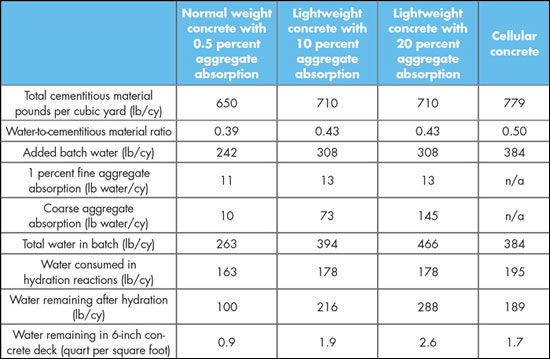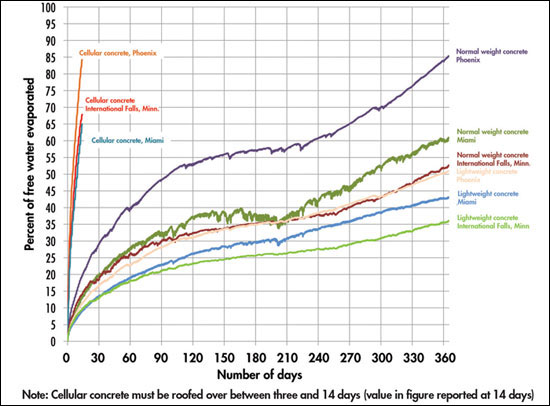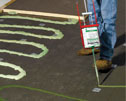Concrete roof decks on buildings constructed during the mid-20th century consist primarily of cast-in-place concrete decks without stay-in-place metal forms or precast concrete elements covered with site-placed topping slabs. Both types of construction allow excess concrete moisture to eventually evaporate from the underside of roof decks.
Before the proliferation of modern roof systems, a typical roof system installed onto concrete decks included a continuous layer of bituminous adhesive that bonded the insulation to the deck. This water-resistant adhesive, applied at about 30 pounds per 100 square feet, also performed as an excellent vapor retarder, reducing the moisture emissions from the concrete into the roofing materials. In addition, typical insulation products of the past had moisture storage capacities higher than those of the foam insulations currently used. Moisture contents of water-sensitive roofing materials remained below levels that caused them to degrade. As a result, older roof systems did not succumb to concrete moisture-related deterioration even though vapor retarder performance may not have been part of the design.
Times have changed
Although many modern roof membranes and insulations are moisture-resistant, modern insulation board often is faced with moisture-sensitive paper facers and is frequently adhered to substrates with moisture-sensitive adhesives. The change to moisture-sensitive adhesives is a result of recent volatile organic compound (VOC) regulations that caused manufacturers to convert to either 100 percent solids, low-VOC or water-based formulations.
Moisture migrating into roof systems from concrete decks also carries alkaline salts and high pH from the concrete. When the moisture, salts and high pH react with moisture-sensitive materials, the paper facers may grow mold, decay and lose cohesive strength; the water-based adhesives may revert to a liquid; and the curing of foam-based adhesives can be altered or delayed. Gypsum and wood-fiber based cover boards may lose cohesive strength. Mold tends to develop when the relative humidity is above 80 percent and temperatures are above 41 F. Internal condensation can occur daily or seasonally as roofing materials are exposed to varying temperatures. Condensed water can degrade adhesives and facers on insulation boards, as well as gypsum-based and other water-soluble materials. High moisture levels in cold regions can lead to freeze-thaw damage of some roofing materials.
Concrete mixes also have changed. In general, concrete mixes made with fly ash or slag are more durable and may contain admixtures (chemicals added to the concrete to cause a specific performance change) that reduce the water content. These improvements in concrete technology result in concrete mixes being less permeable, which slows the drying of moisture from the concrete. Increased use of lightweight structural concrete, with its pre-wetted aggregates, contributes additional moisture to concrete that further extends a concrete deck's drying period.
In addition, roof deck design has changed. Cast-in-place concrete roof deck design may now include composite construction with the steel forms (metal deck) left in place. The metal deck prevents the drying of moisture from the deck's underside. Although some metal decks contain perforations along the ribs (flutes) on the corrugated forms, the perforation area is only 0.25 to 1.5 percent of the metal deck surface, allowing only a minimal amount of moisture evaporation through the forms.
And because current construction schedules usually require a roof system be installed within three to four weeks of placing the concrete roof deck, once a modern roof system is installed, a majority of the concrete moisture will remain entrapped within the completed roof system.
A metal deck form inhibits moisture loss from the concrete deck's underside, and the roof membrane inhibits moisture from leaving through the top of the roof system. Modern roof systems are susceptible to internal condensation, and the wet materials will be at risk of moisture degradation, mold and decay.
Concrete moisture content
Concrete is a mixture of portland cement, aggregates, air voids, water and other additives. A portion of the mix water reacts with the cement and any pozzolanic additives present to form the hydrated binder of the hardened concrete. Additional water provides the fluidity for placement and finishing of freshly mixed concrete. Although chemical admixtures may reduce the amount of additional water required, all freshly placed concrete will contain surplus water that is not consumed in hydration reactions.
The mix water added to the concrete mixture is expressed as the water-to-cementitious material ratio (w/cm). Most concrete mixes are batched at 0.40 to 0.55 w/cm. The cement hydration process, most of which occurs within the first month, consumes about 0.25 w/cm. This leaves an additional 0.15 to 0.30 w/cm, which will remain in the concrete as liquid water.
In addition, the aggregates absorb water—0.1 to 2 percent for normal weight aggregates and between 10 and 30 percent for lightweight aggregates. This water also will be contained within the concrete after it has been placed.

Figure 1: Water added to and remaining in example concrete mixes
To demonstrate how much water remains, we calculated the free water in concrete after hydration for typical roof deck concretes (see Figure 1).
Our calculations show 0.9 to 2.6 quarts of excess water per square foot of concrete surface will be present in a typical one-month-old 6-inch concrete roof deck without accounting for any additional water from the curing process or rain. This is the estimated water that will be available to migrate into a roof system installed after the concrete has developed design strength.
Concrete drying
The freshly placed concrete's interior voids (pores, capillaries and aggregate porosity) initially are saturated with water. When drying begins, concrete loses water by evaporation from the deck's surface. The concrete surface may appear dry, but it may be an illusion. As the surface loses water, diffusion begins, drawing water and alkaline salts from the wet interior to the surface. When roofing materials are installed, the water evaporating from the concrete's top surface becomes sealed within the roof system.
Our company used WUFI, a one-dimensional, validated heat and moisture transport software application, to estimate the drying of concrete decks cast over vented metal decks during the one month before roof system installation and during the two-week exposure as required by the cellular concrete manufacturers. We selected three climate zones across the U.S. as benchmarks for our calculations and assumed there was no added water from a curing process or rain during the initial drying period. To estimate the best conditions for drying, we based the drying simulation on local climate data beginning July 1.

Figure 2: Water remaining in concrete roof decks after one month of exposure
We found the amount of water evaporating from exposed concrete roof decks during the month before installing a roof system, with the exception of cellular concrete, is only a small portion of the available excess water remaining in the concrete roof decks. The water that remains in the deck after this initial period of evaporation is shown in Figure 2.
Our results show there is no location in the U.S. that will dry all the excess water contained in the concrete within 30 days after placement.
Figure 3 shows how much drying can occur if the evaporation time is extended to one year. The graphs are based on the assumption that a deck can be left exposed for one year without precipitation, an unlikely condition without providing temporary protection. Normal weight and lightweight concrete decks will contain water if allowed to dry for one year in all regions.

Figure 3: Water loss by evaporation from vented concrete decks exposed for a year (assuming a July 1 summer casting date and no rain during the entire year)
In the real world, water from curing and precipitation must be taken into account, which means the free water content within the concrete can be expected to remain significantly higher for prolonged time periods.
To evaluate the effect free water in a concrete deck has on roofing materials, we need to consider the vapor drive of the moisture into the roofing materials from the concrete. We use relative humidity to evaluate the vapor drive. When concrete begins drying, the relative humidity within the concrete is 100 percent. As drying continues, the relative humidity decreases.
After roofing materials are installed, the moisture in the concrete raises the relative humidity of the air trapped within the roof system above the concrete deck and begins to cause problems. Typical organic roofing components are susceptible to mold and other decay organisms when the relative humidity is greater than 80 percent for prolonged time periods. Relative humidity also is important for determining when condensation may occur within a roof system and when condensed water may begin deteriorating moisture-sensitive roofing components.
To demonstrate the moisture drive from concrete to roofing materials, we calculated the relative humidity within one-month-old concrete at the time the roofing materials are installed. We found the relative humidity within concrete was above 95 percent in all locations (see Figure 4), indicating the roofing materials will be exposed to deleterious amounts of moisture.

Figure 4: Relative humidity of one-month-old concrete roof deck
Because most roof decks receive a roof system within one month of placement (when concrete is still wet), an alternative approach is needed to address the entrapped water.
Testing for moisture
Roofing contractors have limited ability to evaluate the amount of water present in roof deck concrete and relate that moisture to potential effects on the proposed roof system's durability.
There are several hand-held surface meters that purport to measure concrete's moisture content. These meters supply numeric values, and some indicate the values to be percentages of moisture. This data is best used as arbitrary numbers to compare readings with a concrete surface known to be dry. The problem is that though the meters may display an acceptable value (suggesting a concrete surface might be dry), the concrete's interior is likely to be wet, and this moisture will migrate to the surface after the deck is covered with roofing materials. Moisture meter readings at the surface can provide a false impression concrete is dry.
More generally, there are no adequate tests that can determine acceptable moisture content of roof deck concretes for installing specific roof systems. ASTM International provides standard test methods for determining moisture-related properties of concrete under controlled interior conditions, such as interior concrete floors. These methods include ASTM Standard F1869, "Standard Test Method for Measuring Moisture Vapor Emission Rate of Concrete Subfloor Using Anhydrous Calcium Chloride," and ASTM Standard F2170, "Standard Test Method for Determining Relative Humidity in Concrete Floor Slabs Using in situ Probes." These methods are difficult to use on roof decks because of solar radiation, temperature fluctuations and precipitation.
Another standard, ASTM D4263, "Standard Test Method for Indicating Moisture in Concrete by Plastic Sheet Method," determines the presence of capillary moisture but will not provide moisture levels. The results of the ASTM International tests are extremely difficult to interpret for evaluating the amount of moisture in roof deck concrete that will migrate into a roof system as the roof system undergoes substantial temperature fluctuations.
Currently, NRCA and the Midwest Roofing Contractors Association (MRCA) state a concrete deck is likely to contain levels of water that could be detrimental to a roof system. Methods for testing moisture are discussed in their publications; however, they acknowledge the roofing industry has no acceptable moisture values for the safe application of roofing. MRCA recommends a roof system should include a complete vapor retarder seal. NRCA cautions the decision of when it is appropriate to cover newly placed concrete is beyond roofing contractors' control.
We believe the only reliable method to predict the potential for excessive moisture within a roof system is to perform hygrothermal modeling simulations for the specific environment and roof system being evaluated. Several computer modeling programs are available for conducting these simulations.
Hygrothermal modeling
We conducted hygrothermal modeling of modern roof systems in three climate zones using WUFI. The program models building envelope behavior on an hourly basis (transient) according to interior and exterior climate conditions. We modeled our roof systems for two to five years. To develop an effective model, we considered the local climate because changes in temperature play a major role in moisture migrating out of the concrete and into roofing materials.
Our studies show concrete deck moisture diffuses into roofing materials under all conditions of exterior temperature and humidity in all the geographical locations studied. In all cases, moisture diffused out of the concrete faster than it could diffuse out of the roof system when a vapor retarder is not included. This trend causes moisture to accumulate within the roof system and could result in the deterioration of moisture-sensitive materials in the roof system.
The moisture diffusion in the modeled systems performed differently because the rate at which moisture diffuses out of concrete is based on the temperature profile across the deck system, and the rate at which moisture diffuses from the roof system is based on roof membrane permeance. Other factors include membrane color (which affects solar loads and radiant cooling), type, thickness and the length of the condensation cycles a roof system experiences. Regardless, all the roof systems modeled became wet.
The next step of our hygrothermal modeling included studying the same roof systems but including a vapor retarder. Our goal was to minimize the potential of any components within the roof system from reaching prolonged relative humidity levels greater than 80 percent. Keeping the relative humidity levels below 80 percent would minimize the potential for mold and condensation within the roof system. Our modeling considered the concrete deck's initial moisture content, the roof membrane's moisture permeance, and the temperature profile between exterior and interior surfaces the system will experience during its service life.
We varied the materials and components in the roof system until we found systems that will perform in the specific climates. We reduced the moisture emission out of concrete by adjusting the vapor retarder's permeance of the vapor retarder at the concrete surface. We found a vapor retarder reduces the moisture collection within the roof system to acceptable levels but only if the vapor retarder's permeance is less than the roof membrane's permeance. Vapor retarder selection must be coordinated with the type of roof membrane, and the system must be evaluated for the influence of the local climate.
We did not find systems that will perform equally in all climates. In other words, a system that maintains low moisture within the roof system in a hot-humid climate may not work in a hot-dry climate or cold-moist climate. We found each geographical location required some fine-tuning of the roof system to make it work.
Study conclusions
Typical concrete roof decks installed on steel forms will contain 1 to 2 1/2 quarts of free water per square foot of deck area after the decks have cured. Our moisture analysis demonstrates much of this water will remain in the concrete deck following roof system installation.
Because of construction schedules, roof systems are being installed onto wet concrete even though the concrete's surface may appear dry. Over time, the internal water in the concrete will migrate to the roof system. Without a vapor retarder, a roof membrane will perform as a vapor retarder and trap moisture within the roof system. The entrapped moisture will degrade moisture-sensitive materials. The rate and amount of water migrating into the roof system will depend on the local climate.
Effective roof systems incorporating a vapor retarder can be designed for specific installations and climatic conditions to minimize the detrimental influence of concrete moisture on roofing materials. Developing these designs requires systematic evaluation of all components in the roof and involves hygrothermal modeling calculations.
The numbers presented are based on the ideal conditions of placing, finishing and curing the concrete without adding water during construction or rewetting by rain. In reality, cement will not be fully hydrated and a deck likely will be wet-cured or subjected to some precipitation before application of roofing materials. These conditions will increase the amount of water entrapped in the deck by the time roofing materials are applied.
Recommendations
More research is needed to determine the maximum amount of moisture roofing materials can safely tolerate. In the meantime, roof systems should be designed and installed with vapor retarders to mitigate moisture entrapped in concrete roof decks.
Stephen J. Condren, P.E., is a senior project manager at national engineering firm Simpson Gumpertz & Heger Inc., Boston; Joseph P. Piñon, P.E., is a senior project manager at Simpson Gumpertz & Heger, San Francisco; Paul C. Scheiner, Ph.D., is staff consultant at Simpson Gumpertz & Heger, Boston.



